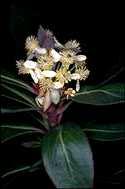

 |
Australian National Botanic Gardens
|
 |
A weekly news sheet prepared by a Gardens' volunteer.
Numbers in square brackets [] refer to garden bed Sections.
Plants in flower are in bold type.
15 October 2004
 |
|
Zieria arborescens
- click for larger image
|
The profusion of spring flowers continues. This week the walk will focus on white flowers, but will lead past many other attractive flowers. Starting at the Visitor Centre, on the left just past the end of the building, a low clump of Rhodanthe anthemoides [Section 208] has everlasting daisy-like flowers. Behind it a male plant of Ricinocarpos speciosus [Section 208] is covered with waxy white flowers. Returning past the Visitor Centre, several orchids with white flowers can be seen on the left, Sarcochilus falcatus and Dockrillia teretifolia (on the wall) and Thelychiton falcorostrus (low, beside the path) [all Section 210].
Past a towering macrozamia, Philotheca ‘Profusion’ [Section 210] lives up to its name. Follow the Main Path, next on the left. Just around the corner on the right is a dainty Derwentia arenaria [Section 210]. A little further, also on the right, is a bushy Westringia ‘Smokie’ with silvery-grey leaves setting off profuse flowers. At the entrance to the walk above the rainforest a tall, spreading Zieria aborescens [Section 148] is heavy with 4-petalled flowers. Zierias are closely related to boronias.
 |
|
Tasmannia purpurescens
- click for larger image
|
On the left, just before the timber path resumes, Citriobatus pauciflorus [Section 65] has minute tube flowers. An occasional orange berry explains the common name Native Orange. Just past an explanatory sign for the Brush Cypress Pine on the right, look up to spot another Thelychiton falcorostrus [Section 146], flowering on a tree. On the left, just before the seat at the vine area, Tasmannia insipida [Section 65] has small but interesting flowers, which will be followed by (usually) purple berries. Take the path to the left and turn down the road between the rainforest and rainforest verge. On the left Zieria sp. [Section 65] has very fine leaves and tiny flowers. Tasmannia stipitata [Section 65] has broad foliage, and will have blackish purple berries. Next a group of Aristotelia australasica [Section 65] display delightful bell-like flowers with notched petals. The flowers of Tasmannia purpurascens [Section 65] are emerging from creamy bracts. Its berries will be bluish to mauve. Members of the genus Tasmannia are known as ‘native peppers’, but the variety used in bush foods is not seen on this walk.
Turn up the next path to the right and walk towards a Mallee Section. Just before the road, on the left close to the ground, Dodonaea boroniifolia has large pink-red fruits. Admire the view over the lake before turning left down the next path. On the right Ricinocarpos bowmanii [Section 211] is covered with waxy flowers. At the corner on the left, just past the model Mallee Fowl and mound, Grevillea anethifolia [Section 211] is covered with heads of fine flowers. On the right Lasiopetalum behrii [Section 211] has nodding sprays of flowers on grey-green, slightly hairy foliage. Leptospermum coriaceum [Section 211], also on the right, is covered with 5-petalled flowers. Opposite Westringia rigida [Section 211] has prominently lipped flowers. Finally, on the left another Dodonaea (viscosa ssp. cineata) is covered with yellow-green fruits.
As you rejoin the road back to the Visitor Centre read the interesting explanatory sign on Mallee Shrublands and look at the large mallee root lying nearby.
Kath Holtzapffel